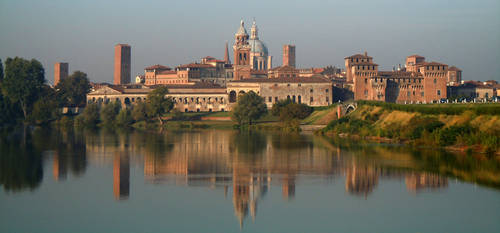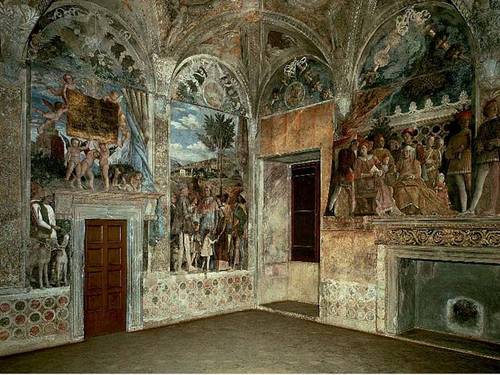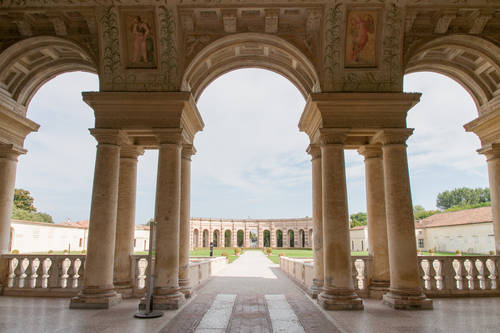Mantova
Mantova and the Gonzaga treasures
Mantova is the home town of Virgilio and the capital of the Gonzaga family, who were enlightened patrons of the arts. During the 15th and 16th centuries, Mantova became one of the main artistic and intellectual centers of northern Italy. Its old center, which belongs to the Unesco Heritage, owes its fascine to some of the greatest Renaissance artists, such as Andrea Mantegna and Giulio Romano.
Departure is planned at 8 AM, and the autobus will be waiting at the crossing point between Paleocapa Street and Jacini Street.

Mantova – CC BY-SA 3.0 | Massimo Telò | 2011
Arrival in Mantova and visit to S.Andrea Church, one of the masterworks of Italian Renaissance architecture whose construction began since 1472 on the project by Leon Battista Alberti. The façade, inspired by classical models of the triumphal arch with three vaults, opens up into a magnificent arcade covered by a tympanum on which sits a great brickwork arch. The impressive inside shows a solemn classical nature and beautiful proportions, and its layout is a Latin cross. The single nave covered by barrel vaults, has chapels on its sides painted with frescos and altarpieces belonging to painters of the 16th century. In the first chapel on the left relies Andrea Mantegna’s grave, who was there buried in 1506.
The Ducale Palace offers an extraordinary complex of buildings, churches, internal squares, gardens and colonnaded connections whose construction and restoration went on from the end of the 13th century to the 18th century. It feels like a “town in the town”. The oldest point of the Palace was built under the first lords of Mantova, the Bonacolsi. Few after the expulsion of the Bonacolsi, the Gonzaga established their dominance, which will last for almost 400 years. They broadened and restructured their house by enriching it with furniture, artistic and naturalistic precious collections. To the complex entailed by Palazzo Ducale belong also Saint George’s castle, the Domus Nova by Luca Fancelli, the exhibition court by Giulio Romano and the basilica palatina of Saint Barbara by Giovanni Battista Bertani.
The Museum of the Palace collects famous artworks, including the knightly pictorical cycle by Pisanello. Furthermore, in Saint Giorgio’s castle is hosted the well-known Camera degli sposi painted by Mantegna (1465-1474), “camera picta” showing life at the court of the Gonzaga. The room, thanks to a powerful trompe l’oeil, turns into an open air pavilion and the walls are linked together with painting, as if space was expanded beyond the physical limits of the room.

Camera degli sposi – CC BY 2.0 | Jennifer Mei | 2012
Lunch is individual.
On the east side of Piazza delle Erbe, which is a lively urban space that derives its name from a colored market of fruits and vegetables, an exceptional series of buildings: from the right, the round of Saint Lorenz, the 14th century Torre dell’Orologio, which was built by Luca Fancelli in 1473 together with the near astronomical-astrological clock, and finally the colonnaded Palazzo della Ragione, from the 12th century. A series of arches covering a suggestive path links the above Palace to the Palazzo del Podesta’, from the 12th century as well, whose rear façade, by the 15th century, closes the square on its northern side.
The Rotonda di S. Lorenzo is among the oldest buildings of Mantova. It was indeed built under Matilde di Canossa at the end of the 11th century, following the example of the sacral sepulchre of Gerusalem. During the 16th century, the Rotonda was integrated to the Jewish district, and was rediscovered only at the beginning of the 20th century, when it went under a radical renovation. The attractive inside is made up of a deambulatorio circumscribed by chunky earthenware columns – with the exemption of the two marble columns beside the presbytery – and is overarched by a matroneum. Its walls host frescos back to the 11-13th centuries.

Palazzo Te – CC BY-SA 4.0 | Errem | 2014
Visit to Palazzo Te, the huge underground villa which was realized by Giulio Romano for Federico II Gonzaga between the 1525 and 1535. In its classical layout it imitates the roman villas. Its inside has a lively decoration with grottesche and frescos, done by the artist and his workshop. The decoration in the Sala di Psiche combines sensuality with energy; the Sala dei Giganti, with its frescoes telling Zeus anger against the Titans, and the Salone dei Cavalli all utterly witness to the style of the artist.
8,30 PM is the estimated time of arrival in Milan.